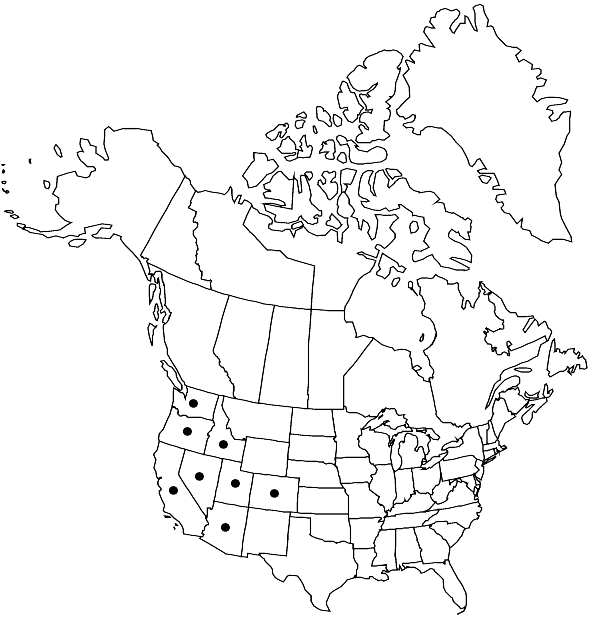Difference between revisions of "Tortula brevipes"
in H. G. A. Engler and K. Prantl, Nat. Pflanzenfam. 214[I,3]: 431. 1902,.
FNA>Volume Importer |
imported>Volume Importer |
||
| (5 intermediate revisions by 2 users not shown) | |||
| Line 1: | Line 1: | ||
{{Treatment/ID | {{Treatment/ID | ||
|accepted_name=Tortula brevipes | |accepted_name=Tortula brevipes | ||
| − | |accepted_authority=(Lesquereux) Brotherus | + | |accepted_authority=(Lesquereux) Brotherus |
|publications={{Treatment/Publication | |publications={{Treatment/Publication | ||
|title=in H. G. A. Engler and K. Prantl, Nat. Pflanzenfam. | |title=in H. G. A. Engler and K. Prantl, Nat. Pflanzenfam. | ||
|place=214[I,3]: 431. 1902, | |place=214[I,3]: 431. 1902, | ||
}} | }} | ||
| − | |basionyms={{Treatment/ID/ | + | |basionyms={{Treatment/ID/Basionym |
|name=Barbula brevipes | |name=Barbula brevipes | ||
|authority=Lesquereux | |authority=Lesquereux | ||
| + | |rank=species | ||
| + | |publication_title=Mem. Calif. Acad. Sci. | ||
| + | |publication_place=1: 12. 1868 | ||
}} | }} | ||
|synonyms={{Treatment/ID/Synonym | |synonyms={{Treatment/ID/Synonym | ||
|name=Barbula macrotrichia | |name=Barbula macrotrichia | ||
|authority=Cardot & Thériot | |authority=Cardot & Thériot | ||
| + | |rank=species | ||
}} | }} | ||
|hierarchy=Pottiaceae;Pottiaceae subfam. Pottioideae;Tortula;Tortula brevipes | |hierarchy=Pottiaceae;Pottiaceae subfam. Pottioideae;Tortula;Tortula brevipes | ||
| Line 36: | Line 40: | ||
-->{{#Taxon: | -->{{#Taxon: | ||
name=Tortula brevipes | name=Tortula brevipes | ||
| − | + | |authority=(Lesquereux) Brotherus | |
| − | |authority=(Lesquereux) Brotherus | ||
|rank=species | |rank=species | ||
|parent rank=genus | |parent rank=genus | ||
| Line 50: | Line 53: | ||
|publication year= | |publication year= | ||
|special status= | |special status= | ||
| − | |source xml=https:// | + | |source xml=https://bitbucket.org/aafc-mbb/fna-data-curation/src/2e0870ddd59836b60bcf96646a41e87ea5a5943a/coarse_grained_fna_xml/V27/V27_850.xml |
|subfamily=Pottiaceae subfam. Pottioideae | |subfamily=Pottiaceae subfam. Pottioideae | ||
|genus=Tortula | |genus=Tortula | ||
Latest revision as of 21:28, 5 November 2020
Leaves short-elliptic or long-obovate, sometimes ovate, apex very broadly acute to rounded, short- to long-awned, margins very broadly recurved or revolute to near apex, not bordered; costa usually long-excurrent, lacking an adaxial pad of cells, distally narrow, ca. 3–4 cells across the convex adaxial surface; distal laminal cells hexagonal, 10–15 µm wide, 1:1, densely papillose with 2-fid papillae. Sexual condition apparently dioicous but more probably rhizautoicous, occasionally autoicous. Sporophytes exerted. Seta length ca. 0.7–1.4(–2) cm. Capsule stegocarpic, not systylius, cylindric, erect and nearly straight, urn length ca. (1.7–)2.5–3.5 mm; peristome 800–1000 µm, teeth of 32 filaments twisted about one full turn, basal membrane 150–200 µm; operculum 1–1.5 mm. Spores ca. 10–13 µm, spheric, finely papillose.
Habitat: Calcareous soil
Elevation: low to moderate elevations
Distribution

Ariz., Calif., Colo., Idaho, Nev., Oreg., Utah, Wash., Mexico (Baja California, Sonora).
Discussion
Tortula brevipes is much like T. muralis, but differs in the soil substrate, absence of a leaf border (common in T. muralis), the apparently dioicous inflorescence, the commonly very long (to 5 mm) operculate capsule, and the well-developed basal membrane of the peristome. According to B. D. Mishler (1994), T. brevipes in Mexico intergrades with T. muralis in capsule length, height of the basal membrane, and development of a leaf border.
Selected References
None.